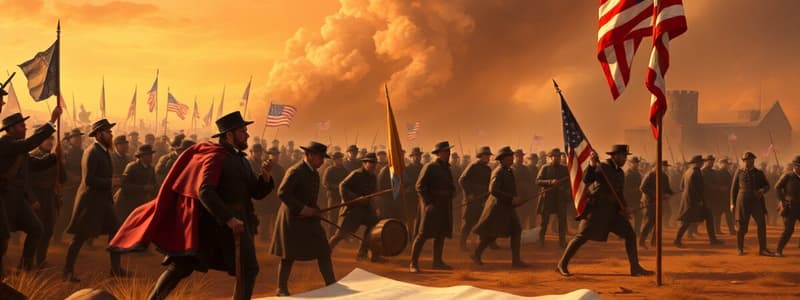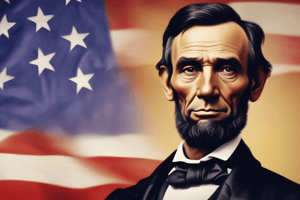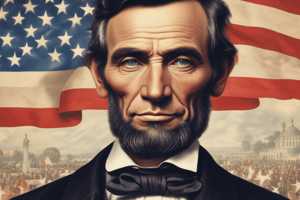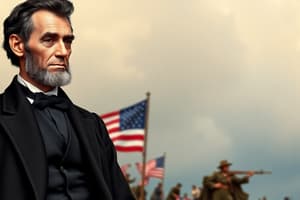Podcast
Questions and Answers
What is the main purpose of the declaration made on January 1, 1863?
What is the main purpose of the declaration made on January 1, 1863?
- To re-establish slavery in the designated states
- To enlist soldiers for the Confederate army
- To declare freedom for all persons held as slaves (correct)
- To encourage states to draft their own amendments
Which states are included in the proclamation of freedom for slaves?
Which states are included in the proclamation of freedom for slaves?
- Only states that were part of the Union
- New states formed after the Civil War
- All Northern states only
- Mississippi, Alabama, Florida, and several others (correct)
What does the proclamation recommend to the freed individuals regarding labor?
What does the proclamation recommend to the freed individuals regarding labor?
- To join the military without any conditions
- To migrate to Northern states for better opportunities
- To avoid working and seek reparations
- To work diligently for reasonable wages (correct)
What role does the proclamation suggest for freed individuals in the military?
What role does the proclamation suggest for freed individuals in the military?
Who signed the proclamation that declared the freedom of enslaved persons?
Who signed the proclamation that declared the freedom of enslaved persons?
Which of these actions does the proclamation urge freed individuals to abstain from?
Which of these actions does the proclamation urge freed individuals to abstain from?
What did Lincoln invoke in response to the proclamation's declaration?
What did Lincoln invoke in response to the proclamation's declaration?
What significant political change is implied by the proclamation?
What significant political change is implied by the proclamation?
What date did the Emancipation Proclamation take effect?
What date did the Emancipation Proclamation take effect?
Which President issued the Emancipation Proclamation?
Which President issued the Emancipation Proclamation?
The Emancipation Proclamation declared freedom for which group of people?
The Emancipation Proclamation declared freedom for which group of people?
What was the purpose of the Emancipation Proclamation as stated by Lincoln?
What was the purpose of the Emancipation Proclamation as stated by Lincoln?
Which states were specifically mentioned as being in rebellion during the proclamation?
Which states were specifically mentioned as being in rebellion during the proclamation?
What criteria was used to determine if a state was in rebellion?
What criteria was used to determine if a state was in rebellion?
What does the Emancipation Proclamation state about the military's role?
What does the Emancipation Proclamation state about the military's role?
What does Lincoln mean by 'good faith' regarding state representation?
What does Lincoln mean by 'good faith' regarding state representation?
What consequence does the proclamation state for all persons held as slaves in the designated states?
What consequence does the proclamation state for all persons held as slaves in the designated states?
Which of the following is emphasized as a responsibility of freed individuals in the proclamation?
Which of the following is emphasized as a responsibility of freed individuals in the proclamation?
According to the proclamation, what is the stance on violence for the freed individuals?
According to the proclamation, what is the stance on violence for the freed individuals?
What aspect does Lincoln invoke in support of the proclamation?
What aspect does Lincoln invoke in support of the proclamation?
Which group does the proclamation specify will be received into the armed service of the United States?
Which group does the proclamation specify will be received into the armed service of the United States?
What geographical areas are excluded from the proclamation's mandate of freedom?
What geographical areas are excluded from the proclamation's mandate of freedom?
What legal authority does Abraham Lincoln claim when issuing the Emancipation Proclamation?
What legal authority does Abraham Lincoln claim when issuing the Emancipation Proclamation?
What date was the Emancipation Proclamation officially issued?
What date was the Emancipation Proclamation officially issued?
Which specific cities are mentioned as exceptions in the proclamation?
Which specific cities are mentioned as exceptions in the proclamation?
How does the Emancipation Proclamation characterize the status of slaves in rebellious states after January 1, 1863?
How does the Emancipation Proclamation characterize the status of slaves in rebellious states after January 1, 1863?
What is implied as necessary evidence for a state's non-rebellious status according to the Emancipation Proclamation?
What is implied as necessary evidence for a state's non-rebellious status according to the Emancipation Proclamation?
What is the underlying rationale for the issuance of the proclamation as stated by Lincoln?
What is the underlying rationale for the issuance of the proclamation as stated by Lincoln?
Which aspect of the military's role is emphasized in the Emancipation Proclamation?
Which aspect of the military's role is emphasized in the Emancipation Proclamation?
What significant political tone does the proclamation carry regarding the future of the states mentioned?
What significant political tone does the proclamation carry regarding the future of the states mentioned?
What timeframe did the Emancipation Proclamation set for the designation of states in rebellion?
What timeframe did the Emancipation Proclamation set for the designation of states in rebellion?
What is the significance of good faith representation in Congress according to the Emancipation Proclamation?
What is the significance of good faith representation in Congress according to the Emancipation Proclamation?
What actions does the proclamation state will be taken regarding freed persons?
What actions does the proclamation state will be taken regarding freed persons?
What is the primary war measure invoked by Lincoln in the Emancipation Proclamation?
What is the primary war measure invoked by Lincoln in the Emancipation Proclamation?
Which of the following actions does the Emancipation Proclamation explicitly state regarding the recognition of freedom?
Which of the following actions does the Emancipation Proclamation explicitly state regarding the recognition of freedom?
Flashcards
Emancipation Proclamation
Emancipation Proclamation
A presidential proclamation issued by Abraham Lincoln on January 1, 1863, declaring slaves in Confederate states free.
January 1, 1863
January 1, 1863
The date of the Emancipation Proclamation.
Rebellion against the US
Rebellion against the US
The act of actively opposing the US government, particularly during the Civil War.
Confederate States
Confederate States
Signup and view all the flashcards
Slaves
Slaves
Signup and view all the flashcards
Abraham Lincoln
Abraham Lincoln
Signup and view all the flashcards
War Measure
War Measure
Signup and view all the flashcards
Proclamation
Proclamation
Signup and view all the flashcards
States Excluded
States Excluded
Signup and view all the flashcards
Military Necessity
Military Necessity
Signup and view all the flashcards
Executive Government
Executive Government
Signup and view all the flashcards
Suitable Condition
Suitable Condition
Signup and view all the flashcards
Reasonable Wages
Reasonable Wages
Signup and view all the flashcards
Emancipation Dates
Emancipation Dates
Signup and view all the flashcards
Designated States
Designated States
Signup and view all the flashcards
Violence Abstain
Violence Abstain
Signup and view all the flashcards
What did the Emancipation Proclamation do?
What did the Emancipation Proclamation do?
Signup and view all the flashcards
When was the Proclamation issued?
When was the Proclamation issued?
Signup and view all the flashcards
Who issued the Emancipation Proclamation?
Who issued the Emancipation Proclamation?
Signup and view all the flashcards
Which states were excluded from the Proclamation?
Which states were excluded from the Proclamation?
Signup and view all the flashcards
Why were some states excluded?
Why were some states excluded?
Signup and view all the flashcards
What was the military necessity?
What was the military necessity?
Signup and view all the flashcards
What did the Proclamation say about freedmen?
What did the Proclamation say about freedmen?
Signup and view all the flashcards
What did the government promise?
What did the government promise?
Signup and view all the flashcards
What was the goal of the Proclamation?
What was the goal of the Proclamation?
Signup and view all the flashcards
What did Lincoln invoke?
What did Lincoln invoke?
Signup and view all the flashcards
What is the main purpose?
What is the main purpose?
Signup and view all the flashcards
What was the primary method?
What was the primary method?
Signup and view all the flashcards
What were the excluded areas?
What were the excluded areas?
Signup and view all the flashcards
What was Lincoln's role?
What was Lincoln's role?
Signup and view all the flashcards
What is a proclamation?
What is a proclamation?
Signup and view all the flashcards
Why was it issued?
Why was it issued?
Signup and view all the flashcards
What did it declare?
What did it declare?
Signup and view all the flashcards
What did it impact?
What did it impact?
Signup and view all the flashcards
How did it affect the war?
How did it affect the war?
Signup and view all the flashcards
What was its significance?
What was its significance?
Signup and view all the flashcards
Study Notes
Emancipation Proclamation, January 1, 1863
- Issued by President Abraham Lincoln
- A proclamation declaring slaves in Confederate states free
- Effective January 1, 1863
- Included specific Confederate states and territories
- States and parts of states in rebellion were specified
- Designated states excluded were Parishes of St. Bernard, Plaquemines, Jefferson, St. John, St. Charles, St. James Ascension, Assumption, Terrebonne, Lafourche, St. Mary, St. Martin, and Orleans (including the city of New Orleans), Mississippi, Alabama, Florida, Georgia, South Carolina, North Carolina, and Virginia (except the forty-eight counties designated as West Virginia, and the counties of Berkley, Accomac, Northampton, Elizabeth City, York, Princess Ann, and Norfolk, including the cities of Norfolk and Portsmouth).
- Enslaved people in states and parts of states in rebellion against the United States would be freed
- The executive government of the United States, including the military and naval forces, would recognize and maintain the freedom of these newly freed people.
- Encouraged newly freed people to work for fair wages
- Allowed newly freed people of suitable condition to enlist in the armed forces
Studying That Suits You
Use AI to generate personalized quizzes and flashcards to suit your learning preferences.




